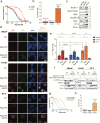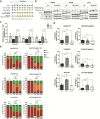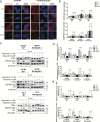Pre-activation of autophagy impacts response to olaparib in prostate cancer cells
- PMID: 35318456
- PMCID: PMC8940895
- DOI: 10.1038/s42003-022-03210-5
Pre-activation of autophagy impacts response to olaparib in prostate cancer cells
Abstract
Poly (ADP-ribose) polymerase 1 (PARP1) plays an essential role in DNA repair and is targeted by anticancer therapies using PARP inhibitors (PARPi) such as olaparib. PARPi treatment in prostate cancer (PC) is currently used as a monotherapy or in combination with standard therapies (hormonotherapy) in clinical trials for patients with DNA damage response mutation. Unfortunately, 20% of these patients did not respond to this new treatment. This resistance mechanism in PC is still not well understood. Here, we report that autophagy affects differently the response of PC cell lines to olaparib depending on its activation status. Pre-activation of autophagy before olaparib resulted in an increase of DNA repair activity by homologous recombination (HR) to repair double-strand breaks induced by olaparib and enhanced cell proliferation. When autophagy was activated after olaparib treatment, or completely inhibited, PC cells demonstrated an increased sensitivity to this PARPi. This autophagy-mediated resistance is, in part, regulated by the nuclear localization of sequestrosome 1 (SQSTM1/p62). Decrease of SQSTM1/p62 nuclear localization due to autophagy pre-activation leads to an increase of filamin A (FLNA) protein expression and BRCA1/Rad51 recruitment involved in the HR pathway. Our results reveal that autophagy basal levels may in part determine amenability to PARPi treatment.
© 2022. The Author(s).
Conflict of interest statement
F.S. is an advisory board member (personal) and has received research funding (institutional) from AstraZeneca, Pfizer, Astellas, Bayer and Janssen.
Figures






Similar articles
-
Histone deacetylase inhibitor, suberoylanilide hydroxamic acid (SAHA), enhances anti-tumor effects of the poly (ADP-ribose) polymerase (PARP) inhibitor olaparib in triple-negative breast cancer cells.Breast Cancer Res. 2015 Mar 7;17:33. doi: 10.1186/s13058-015-0534-y. Breast Cancer Res. 2015. PMID: 25888415 Free PMC article.
-
Prexasertib treatment induces homologous recombination deficiency and synergizes with olaparib in triple-negative breast cancer cells.Breast Cancer Res. 2019 Sep 6;21(1):104. doi: 10.1186/s13058-019-1192-2. Breast Cancer Res. 2019. PMID: 31492187 Free PMC article.
-
Poly(ADP-ribose)polymerase (PARP) inhibition and anticancer activity of simmiparib, a new inhibitor undergoing clinical trials.Cancer Lett. 2017 Feb 1;386:47-56. doi: 10.1016/j.canlet.2016.11.010. Epub 2016 Nov 12. Cancer Lett. 2017. PMID: 27847302
-
Olaparib.Recent Results Cancer Res. 2018;211:217-233. doi: 10.1007/978-3-319-91442-8_15. Recent Results Cancer Res. 2018. PMID: 30069770 Review.
-
Olaparib for the treatment of metastatic prostate cancer.Future Oncol. 2021 Jul;17(19):2413-2429. doi: 10.2217/fon-2020-1245. Epub 2021 Mar 26. Future Oncol. 2021. PMID: 33769071 Review.
Cited by
-
LightSpot Fluorescent Conjugates as Highly Efficient Tools for Lysosomal P-gp Quantification in Olaparib-Treated Triple-Negative Breast Cancer Cells.Int J Mol Sci. 2025 Jul 11;26(14):6675. doi: 10.3390/ijms26146675. Int J Mol Sci. 2025. PMID: 40724925 Free PMC article.
-
A genome-wide CRISPR-Cas9 knockout screen identifies novel PARP inhibitor resistance genes in prostate cancer.Oncogene. 2022 Sep;41(37):4271-4281. doi: 10.1038/s41388-022-02427-2. Epub 2022 Aug 6. Oncogene. 2022. PMID: 35933519
-
Is autophagy induction by PARP inhibitors a target for therapeutic benefit?Oncol Res. 2022 Dec 6;30(1):1-12. doi: 10.32604/or.2022.026459. eCollection 2022. Oncol Res. 2022. PMID: 37304006 Free PMC article. Review.
-
Crizotinib Enhances PARP Inhibitor Efficacy in Ovarian Cancer Cells and Xenograft Models by Inducing Autophagy.Mol Cancer Res. 2024 Sep 4;22(9):840-851. doi: 10.1158/1541-7786.MCR-23-0680. Mol Cancer Res. 2024. PMID: 38780897 Free PMC article.
-
Development of Olaparib-Resistance Prostate Cancer Cell Lines to Identify Mechanisms Associated with Acquired Resistance.Cancers (Basel). 2022 Aug 11;14(16):3877. doi: 10.3390/cancers14163877. Cancers (Basel). 2022. PMID: 36010871 Free PMC article.
References
Publication types
MeSH terms
Substances
LinkOut - more resources
Full Text Sources
Medical
Research Materials
Miscellaneous

